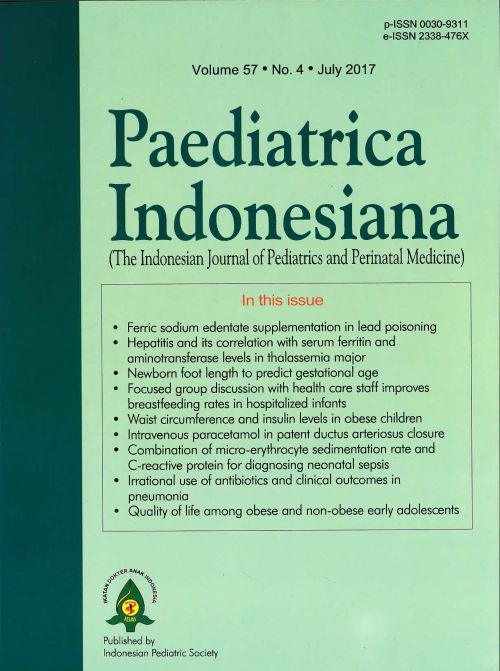Effectiveness of ferric sodium edentate supplementation in children with lead poisoning
DOI:
https://doi.org/10.14238/pi57.4.2017.171-5Keywords:
lead poisoning, blood lead levels, NaFeEDTAAbstract
Background Lead is a harmful toxin that affects human health worldwide, especially in children. Lead poisoning remains a global problem both in developed and developing countries. The Centers for Disease Control and Prevention (CDC) recommends nutritional intervention with iron supplementation to efficiently control high lead levels. Iron supplementation in the form of sodium ferric ethylene-diaminetera-acetic acid/ ferric sodium edentate (NaFeEDTA) is highly bioavailable.
Objective To determine the effectiveness of ferric sodium edentate (NaFeEDTA) on lead levels in children woaj ;ead [pospmomg.
Methods  This interventional, analytical study, had a one group pretest-posttest design, and was done on children in four elementary schools in the Talawaan District, North Minahasa Regency from August to November 2014. Inclusion criteria were elementary students aged 6-9 years with lead poisoning (lead levels ≥ 10 μg/dL) and good nutritional status. Subjects were given NaFeEDTA 115.4 mg (15 mg elemental iron) at a dosage of 3 mg/kgBW/day elemental iron given between meal times. Iron supplementation was given daily per oral route for 12 weeks. Descriptive analysis was used to analyze the characteristics of the study sample. Pre- and post-test analyses were done with paired T-tests. Significance level was P <0.05.
Results In this study, 39 children met the inclusion criteria and consisted of 19 boys and 20 girls. Their mean age was 8.43 (SD 0.44) years. Pre-test and post-test blood lead levels was 36.18 μg/dL and 5.22 μg/dL, respectively.There was a significant reduction in mean blood lead levels after administration of NaFeEDTA (P <0.0001).
Conclusion In children with lead poisoning, blood lead levels are significantly reduced after 12 weeks of NaFeEDTA supplementation.
References
Markowitz M. Lead poisoning. In: Behrman RE, Kliegman RM, Jenson HB, editors. Nelson textbook of pediatrics. 18th ed. Philadelphia: Saunders; 2010. p. 2913-7.
Sakai T. Biomarkers of lead exposure. Ind Health. 2000;38:127-42.
Albalak R, Noonan G, Buchanan S, Flanders WD, Gotway-Crawford C, Kim D, et al. Blood lead levels and risk factors for lead poisoning among children in Jakarta, Indonesia. Sci Total Environ. 2003;301:75-85.
Kwong WT, Friello P, Semba RD. Interactions between iron deficiency and lead poisoning: epidemiology and pathogenesis. Sci Total Environ. 2004;330:21-37.
Ahamed M, Singh S, Behari JR, Kumar A, Siddiqui MK. Interaction of lead with some essential trace metals in the blood of anemic children from Lucknow, India. Clin Chim Acta. 2007;377:92-7.
Kim HS, Kim MK, Lee BK. Oral supplementation with NaFeEDTA reduces blood lead in postmenopausal but not premenopausal Korean women with anemia. Nutrition. 2009;25:66-71.
Elsenhans B, Janser H, Windisch W, Schuman K. Does lead use the intestinal absorptive pathways of iron? Impact of iron status on murine 210Pb and 59Fe absorption in duodenum and ileum in vivo. Toxicology. 2011;284:7-11.
Gunawan L, Masloman N. Hubungan kadar timbal dengan kecerdasan intelektual pada anak. [Thesis]. [Manado]: FK Unsrat; 2012.
Binns HJ, Campbell C, Brown MJ. Interpretating and managing blood lead levels of less than 10 microg/dL in children and reducing childhood exposure to lead: recommendations of the Centers for Disease Control and Prevention Advisory Committee on Childhood Lead Poisoning Prevention. Pediatrics. 2007;120:1285-98.
Wardhini BP, Dewoto HR. Anti anemia defisiensi. In: Setiabudi R, Suyatna F, Purwantyastuti, Nafrriald, editors. Farmakologi dan terapi FKUI. 5th ed. Jakarta: Gayabaru; 2002. p. 738-41.
Bellinger DC, Needleman HL, Eden AN. Intellectual impairment and blood lead levels. N Engl J Med. 2003;349:500-2.
Liebelt EL, Schonfield DJ, Gallagber P. Elevated blood lead levels in children are associated with lower erythropoietin concentrations. J Pediatr. 1999;134:107-9.
Chandran L, Cataldo R. Lead poisoning: basics and new developments. Pediatr Rev. 2010;31:399-406.
Chiodo LM, Jacobson SW, Jacobson JL. Neurodevelopmental effects of postnatal lead exposure at very low levels. Neurotoxicol Teratol. 2004;26:359-71.
Brown MJ, Raymond J, Homa D, Kennedy C, Sinks T. Association between children’s blood lead levels, lead service lines, and water disinfection, Washington, DC, 1998-2006. Environ Res. 2011;111:67-74
Barbosa JF, Fillion M, Lemire M, Passos CJ, Rodrigues JL, Philibert A, dkk. Elevated blood lead levels in a riverside population in the Brazilian Amazon. Environ Res. 2009;109:594-9. US CDC. Notes from the field: outbreak of acute lead poisoning among children aged <5 years – Zamfara, Nigeria. Morb Mortal Wkly Rep. 2010;59:846.
Lubis B, Rosdiana N, Nafianti S, Rasyianti O, Panjaitan FM. Hubungan keracunan timbal dengan anemia defisiensi besi pada anak. CDK-200. 2013;40:17-21.
Advisory Committee on Childhood Lead Poisoning Prevention. Interpreting and managing blood lead level < 10mg/dL in children and reducing childhood exposure to lead. Washington: CDC-MMWR Recommendations and Reports; 2007. p. 1-19.
Wolf AW, Jimenez E, Lozoff B. Effect of iron therapy on infant blood lead levels. J Pediatr. 2003;143:789-95.
Wang Q, Luo W, Zhang W, Liu M, Song H, Chen J. Involvement of DMT1 +IRE in the transport of lead in an in vitro BBB model. Toxicol In Vitro. 2011;25:991-8.
Cuilan Y, Jianchun Y, Shuyue K, Chunyan W, Qi Z. Clinical efficacy and influence on blood Pb of NaFeEDTA oral sotulion in treatment of iron deficiency anemia in children. [cited 2014 April 14]. Available from: http://cnki.com.cn
Zimmermann MB, Muthayya S, Moretti D, Kurpad A, Hurrell RF. Iron fortification reduces blood lead levels in children in Bangalore, India. Pediatrics. 2006;117:2014-21.
Downloads
Published
How to Cite
Issue
Section
License
Authors who publish with this journal agree to the following terms:
Authors retain copyright and grant the journal right of first publication with the work simultaneously licensed under a Creative Commons Attribution License that allows others to share the work with an acknowledgement of the work's authorship and initial publication in this journal.
Authors are able to enter into separate, additional contractual arrangements for the non-exclusive distribution of the journal's published version of the work (e.g., post it to an institutional repository or publish it in a book), with an acknowledgement of its initial publication in this journal.
Accepted 2017-07-04
Published 2018-01-05














